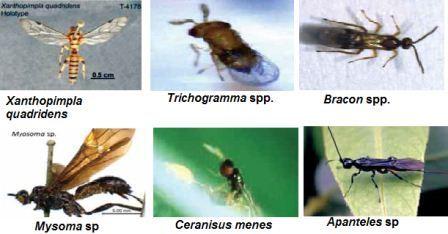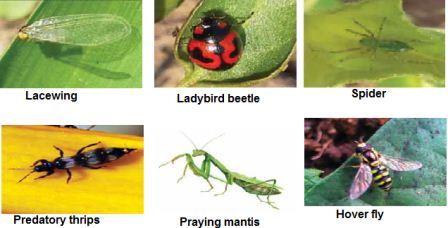Ginger: Natural Enemies
Ginger: Natural Enemies
Natural Enemies of Ginger Insect Pests
Parasitoids

Predators

Flowering plants that attract natural enemies/repel pests
| Natural enemies | Attractant/Repellent/Trap plants |
| Shoot borer: | |
| • Parasitoids: Bracon sp (larval), myosoma sp (larval), Apanteles sp (larval) , Xanthopimpla sp (larval and pupal) etc., • Predators: Chrysoperla zastrowi sillemi, coccinellids, king crow, wasp, dragonfly, spiders, robber fly, reduviid bug, praying mantids, fire ants Entomopathogenic nematode (EPN) of the genus Rhabditis/Oscheius and Hexamermis sp. |
• Attractant plants for natural enemies: Carrot family, sunflower family, buckwheat, alfalfa, corn, shrubs (lacewing and ladybird beetle). • Nectar rich plants with small flowers i.e. anise, caraway, dill, parsley, mustard, sunflower, buckwheat and cowpea (braconid wasp) • Maintaining hedgerows around the turmeric plantation also helps to maintain a population of ladybird beetle, spiders, etc. • Mulching with green leaves @ 4–4.5 t/acre at the time of planting. It is repeated @ 2 t/acre at 40 and 90 days after planting. • Use of Lantana camara and Vitex negundo as mulch at the time of planting may reduce the infection of shoot borer. • EPN Rhabditis/Oscheius as biopesticides for management of the shoot borer and other insect pests of turmeric. |
| Soft rot: | |
| • Incorporation of neem cake and pine needle in the soil. • Different types of cropping systems cropping like maize, papaya, cucumber, pumpkin, yam, tapioca and different types of leguminous crops. • Application of oil cakes made from Azadirachta indica, Calophyllumino phyllum, Pongamia glabra, Hibiscus sabdariffa and Brassica campestris • Intercrop ginger with maize and pineapple. |
|
| Bacterial wilt: | |
| Plant Growth Promoting Rhizobacteria (PGPR) | • Raised bed 30 cm with 1 meter width. • Crop rotation with maize, cotton, and soybean. • Incorporation of Pseudomonas spp. AM and other BCAs @ 1Kg/per acre with well decomposed FYM • AM fungi |
| Fusarium wilt or yellows: | |
| • Raised bed. • Practice Biodisinfestation procedures like soil incorporation of cruciferous plants, soil solarisation during hottest months for 60 days. • Apply pine needle and neem cake powder soil treatments. |
|
| Root-knot nematode: | |
| • Intercropping with marigold @ 5:1 • Deep ploughing or solarized beds of infested fields during summer. • Repellant plants for nematodes: Marigold plantation, Gliricidia, Asparagus, Dahelia etc. • Crop rotation: Marigold, Chrysanthemum, Sesbania, Crotalaria spp., Gaillardia, castor bean and Desmodium spp., • Border crops: Strips of rye grass, cover crops and mulch beds (rove beetle) • Soil incorporation of Gliricidia compost, neem cake 0.8 t / acre |
|
IPM for Ginger
To know the IPM practices for Ginger, click here.
Source: NIPHM and Directorate of Plant Protection, Quarantine & Storage
Last Modified : 12/23/2019
© C–DAC.All content appearing on the vikaspedia portal is through collaborative effort of vikaspedia and its partners.We encourage you to use and share the content in a respectful and fair manner. Please leave all source links intact and adhere to applicable copyright and intellectual property guidelines and laws.
RELATED ITEMS
Amla Beneficial insects
This topic covers information about Amla Beneficia...
Arecanut Beneficial Insects
This topic covers information about Arecanut: Bene...
Apple: Natural Enemies
Natural enemies of apple insect pests are covered ...
Ber Beneficial Insects
This topic covers information about Ber Beneficial...
